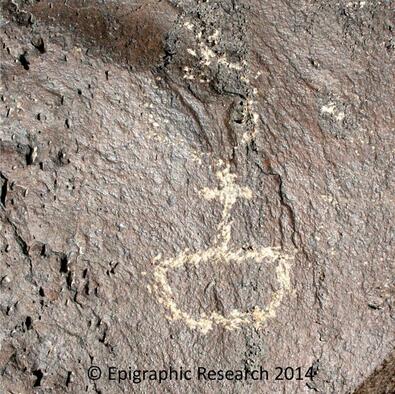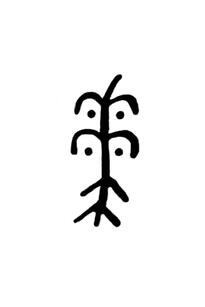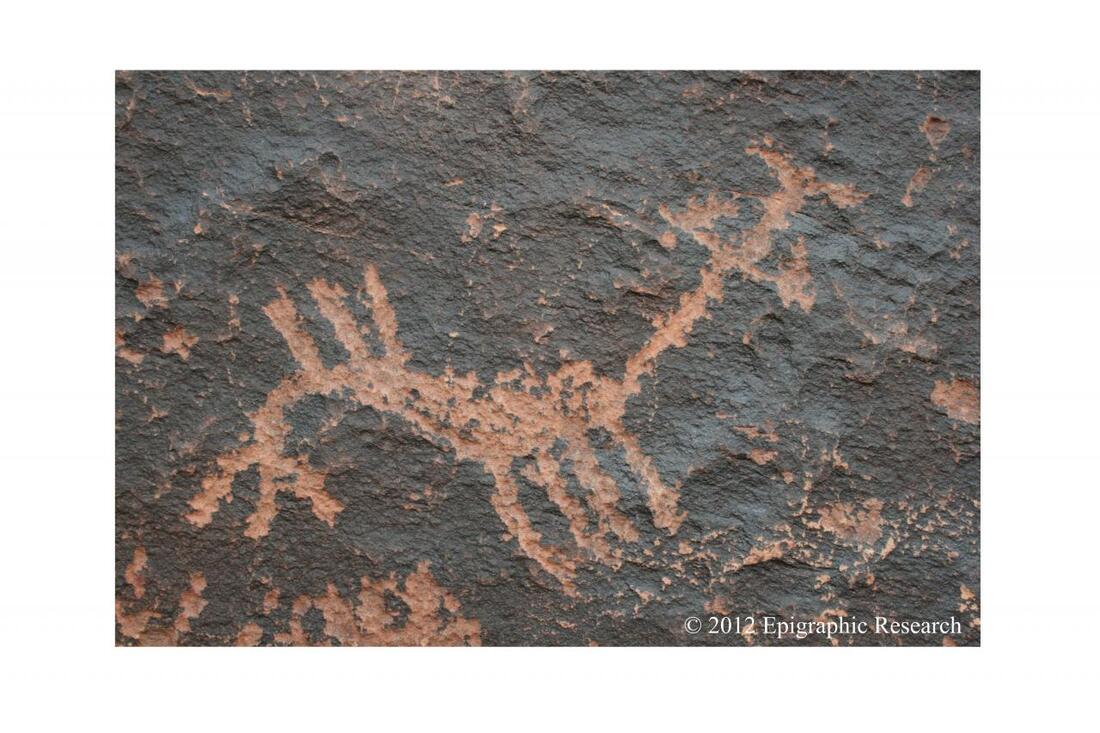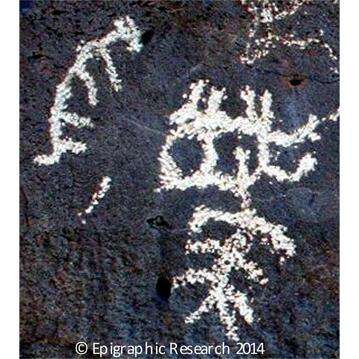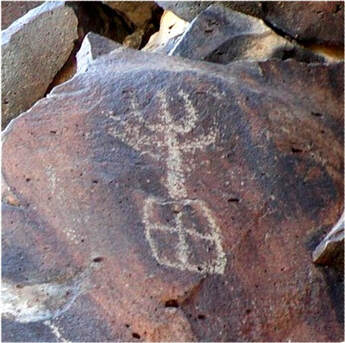a few SAMPLES OF Research Published in Asiatic Echoes
The following are examples of some of the ancient Chinese scripts identified in the North American rock writing record which are analyzed in greater detail in Asiatic Echoes, 3rd edition.
A traditional ancient Chinese divination found in the North American rock writing record.
These two equally old oracle-bone Chinese pictogram-glyphs actually physically connect. Here they form a readable traditional ancient Chinese oracle-bone prognostication. In brief, they translate as: "The next 10-day period will be auspicious." This is a classic example of a Chinese oracle-bone era divination. The presence of such a message in North American Rock Writing indicates that ancient Asiatic people were present in the Americas about 1000 BC, for oracle-bone writing fell into disuse around this time and it was not until AD 1899 that it was rediscovered and subsequently deciphered in China. It has taken many years to translate these symbols. Even today only about 50% of oracle-bone pictograms have been decoded. Hence, these old and repatinated glyphs (age confirmed by senior NPS staff) could only have been made by ancient Chinese explorers shortly after the end of the Shang dynasty, when the script became lost to human memory for the next 2900 years.
Noteworthy is the fact that both Native Americans and Asiatic people followed 10-day sacred calendars. This most curious fact was noted by Michael Zeilik in his 1986 treatise titled: The Ethnoastronomy of Historic Pueblos, II Moon Watching. Here he wrote that the Native American 10-day calendar is "a tradition also found among arctic and subarctic peoples in Asia."
Noteworthy is the fact that both Native Americans and Asiatic people followed 10-day sacred calendars. This most curious fact was noted by Michael Zeilik in his 1986 treatise titled: The Ethnoastronomy of Historic Pueblos, II Moon Watching. Here he wrote that the Native American 10-day calendar is "a tradition also found among arctic and subarctic peoples in Asia."
The ancient Chinese rock writing record of a ritual sacrificial offering likely made to honor the 3rd Shang dynasty king, Da Jia.
Note: Ancient Chinese script was not standardized. Consequently, considerable variation in found in the writing of ancient Chinese scripts as scribes from the period drew pictograms using their own unique and personal styles, in much the same manner as modern signatures vary from person to person yet are generally understandable.
Beginning at the far right and reading to the left as Chinese writing: First, the symbol of Geng provides a day-date for this event. The next pictogram-glyph of Jie portrays a man kneeling reverently before a superior. To the left of Jie is the Chinese pictogram of Da, meaning "Great." It is a symbol often used to indicate a high official in China... and this one is greatly embellished. The Da script is followed by the ancient pictogram of Quan (dog), and the message concludes with the complex ancient form of the tripartite pictogram Xian (meaning to offer ritual cult sacrifice).
A Very Important Consideration
All of these petroglyphs evidence a significant level of repatination, indicating that they were created long ago and not within the past 150 years (this age estimation verified onsite by independent and knowledgeable National Park Service personnel). This level of repatination (weathering) is consistent with some age, unlike the unfortunate examples of modern graffiti found nearby, which nevertheless are useful for comparative dating purposes. See the un-retouched photo at bottom of this website's page on "Ongoing Supplemental Research" to make a visual comparison of the repatination evident on these pictogram-glyphs with the whiter color exhibited by nearby modern graffiti.
As knowledge of several of the styles of ancient Chinese script pecked long ago into this boulder were lost to mankind shortly after the fall of the Shang dynasty in 1046 BC, and were not re-discovered and subsequently deciphered until AD 1899 in Anyang, China, these images cannot be viewed as recent spurious fabrications (fakes).
Beginning at the far right and reading to the left as Chinese writing: First, the symbol of Geng provides a day-date for this event. The next pictogram-glyph of Jie portrays a man kneeling reverently before a superior. To the left of Jie is the Chinese pictogram of Da, meaning "Great." It is a symbol often used to indicate a high official in China... and this one is greatly embellished. The Da script is followed by the ancient pictogram of Quan (dog), and the message concludes with the complex ancient form of the tripartite pictogram Xian (meaning to offer ritual cult sacrifice).
A Very Important Consideration
All of these petroglyphs evidence a significant level of repatination, indicating that they were created long ago and not within the past 150 years (this age estimation verified onsite by independent and knowledgeable National Park Service personnel). This level of repatination (weathering) is consistent with some age, unlike the unfortunate examples of modern graffiti found nearby, which nevertheless are useful for comparative dating purposes. See the un-retouched photo at bottom of this website's page on "Ongoing Supplemental Research" to make a visual comparison of the repatination evident on these pictogram-glyphs with the whiter color exhibited by nearby modern graffiti.
As knowledge of several of the styles of ancient Chinese script pecked long ago into this boulder were lost to mankind shortly after the fall of the Shang dynasty in 1046 BC, and were not re-discovered and subsequently deciphered until AD 1899 in Anyang, China, these images cannot be viewed as recent spurious fabrications (fakes).
The Chinese script petroglyphs for a mesa and for the number five on a single boulder.
An ancient North American Chinese rock writing describing a boat upon water at Little Lake.
Chinese seal era boat petroglyph.
Note there is a water line attached at the top left of this petroglyph (left photo) which is equivalent to the curved line atop the script pictogram (right illustration).
Chinese oracle-bone script boat petroglyph
This Chinese rooted image is frequently (somewhat understandably) mis-interpreted by rock art researchers as the depiction of a ladder. However, in this research study, before such petroglyph or pictogram images are classified as a "boat," the symbol must be clearly augmented by an attached water line(s). In the above photograph note that the top of the right side vertical line continues down the right edge of the boulder. Although not visible in this photograph, this line becomes very wavy and continues for another 5 or 6 feet across the adjoining side of the rock.
A unique highly stylized ancient Chinese dog petroglyph
The ancient Chinese script symbol Shi2, meaning "period of time"
Note: This script is located with a depiction of the Moon above it and 3 concentric circles below. When read together these items describe the period of a lunar month in a manner only used in ancient China and by Native Americans.
Chinese script for a very beautiful flower
Shown above are the images of a North American petroglyph alongside an equally old Chinese pictogram of a beautiful flower. Note: The "plus over minus" at the base of the petroglyph's vertical centerline is the Chinese symbol Tu, meaning ground, dirt, or earth. Evidently, the ancient author of this glyph possessed a considerable Chinese vocabulary and substituted the symbol for dirt in place of the more frequently used root lines of the plant. The clear level of repatination upon this petroglyph indicates that it could not be of recent manufacture, a fact confirmed by NPS staff.
Ancient Chinese script elephant
Augmented by the addition of four leg-lines this North American petroglyph is constructed of the same basic line-strokes found in the ancient Chinese script pictogram Xiang, meaning elephant. The three diagonal lines on the back of the petroglyph correspond with the two diagonal lines on the back of the pictogram, which denote hair in early Chinese writing. Particularly note the sharpness of the two tusks embellishing the petroglyph image and its bifurcated trunk, both of which are characteristic features of elephants.
Very often Chinese pictograms have more than one meaning. To properly interpret them one must consider the context in which the symbol is found. (Example: When spoken the English words "night" and "knight" sound the same but convey different meanings based upon the context in which they are expressed.)
Consequently, in addition to its primary meaning "elephant," the Xiang pictogram may also be interpreted as "image" or "picture." Curiously, because of the large number of petroglyphs found upon this boulder the modern name for the location is "Newspaper Rock." Accordingly, rather than informing us about an animal this particular symbol may have been placed where we find it today as an ancient reference (something like "picture rock") for this location, a spot literally adorned by hundreds of petroglyph images.
Very often Chinese pictograms have more than one meaning. To properly interpret them one must consider the context in which the symbol is found. (Example: When spoken the English words "night" and "knight" sound the same but convey different meanings based upon the context in which they are expressed.)
Consequently, in addition to its primary meaning "elephant," the Xiang pictogram may also be interpreted as "image" or "picture." Curiously, because of the large number of petroglyphs found upon this boulder the modern name for the location is "Newspaper Rock." Accordingly, rather than informing us about an animal this particular symbol may have been placed where we find it today as an ancient reference (something like "picture rock") for this location, a spot literally adorned by hundreds of petroglyph images.
Oracle-bone era Chinese teeth
Little more need be said about these two side-by-side images. The probability that these two complex images were independently drawn with almost identical lines solely by chance (calculated by application of the Jaccard Similarity Coefficient) is less than one in a thousand.
A Chinese oracle-bone era thorn petroglyph
Note the sunlight oval shown in the above photo moves from right to left along the line of the plant's crossbar branches on the date of the summer solstice. Evidently, this image was employed as a directional marker as in Arizona a second occurrence of this same pictogram displays an identical directional alignment. Note: this petroglyph is clearly weathered and is not a recent creation. As knowledge of the ancient Chinese oracle-bone script style of this glyph was not rediscovered until 1899, after it was lost to mankind's memory over 2000 years ago, this glyph cannot be considered as a specious modern fabrication.
Chinese ancient script for a large tree
Depicting a large and mature tree with many branches, the lines of this Arizona pictogram-glyph perfectly match the complex pattern of the Wei pictogram shown above. Especially note the upward curve of each set of branches and the 45 degree angle of each root. The probability of separately drawing these two identical images purely by chance is less than one in a thousand. (see page 111, chart 118 of Asiatic Echoes, 3rd Edition)
An ancient Chinese sacrificial offering in New Mexico
This highly complex and readable ancient Chinese script, composed of three separate symbols, is one of the most demonstrable proofs that literate Chinese individuals were present in the Americas in pre-Columbian times. Written upon a rock panel along with the equally ancient Chinese scripts of Quan (dog), Da (Great), Jie (to kneel in reverence), Da Jia (the 3rd Shang king), and the symbol of Geng (the 7th Heavenly Stem), together these images preserve the message of a traditional ancient Chinese religious sacrifice.
The twisted strands of a thread or rope
This is a very common symbol found at numerous dispersed sites across the Southwestern United States. In the Petrified Forest of Northern Arizona, this pictogram-glyph is closely associated with the equally ancient Xiang (elephant) script symbol shown above, and also with the ancient Chinese symbols of zhou (boat) and shui (water).
A complex oracle-bone era script for "nation" (Bang1) located in the Mojave Desert of Southern California
Note: This pictogram-glyph of the ancient Chinese script of Bang1 is found in association with numerous other ancient Chinese symbols at this site, several of which form readable messages.
|
About the Images
Copyrighted works appear on this website. All use of such names or works is for educational purposes only and solely to the benefit of the trademark or copyright owner, with no intention of infringing upon that trademark or copyright. The entire contents of this website are Copyright 2016 Epigraphic Research, All Rights Reserved, unless otherwise noted. Images and photographs appearing on this website are © 2010 - 2021 Epigraphic Research, unless otherwise noted. Access to this site does not grant any rights to copy, publish, sell, license, distribute or use any included materials, including photographs, text, backgrounds or design elements in any form or media, without the expressed and written permission of the copyright holder. Please use the Contact Us link to the left if you would like to use any of the website imagery or text. |
Contact us today!
Epigraphic Research welcomes your questions and queries. Please use our "Contact Us" page to send us your questions and comments. |
